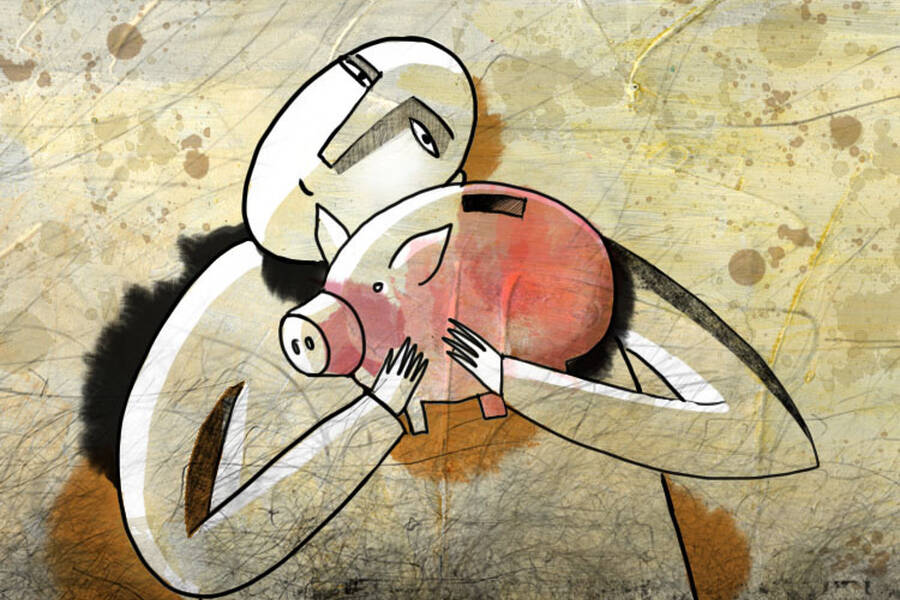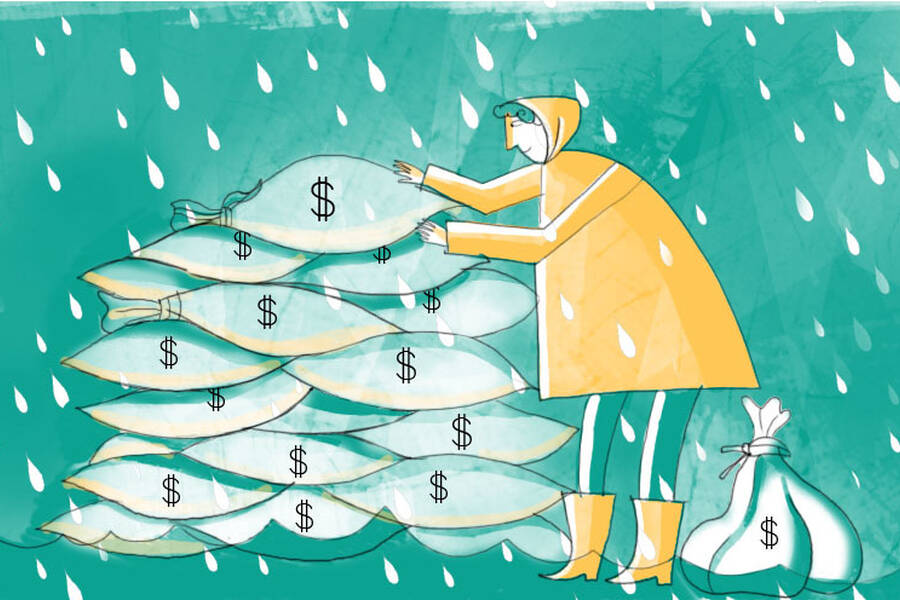Finance & Accounting Innovation May 5, 2020
Taking on Debt Can Help a Company Grow—Until a Crisis Hits
A new study shows how highly leveraged companies have less flexibility to innovate in a downturn.

Michael Meier
On September 30, 2005, the Danish newspaper Jyllands-Posten published a set of cartoons of Muhammad that ignited outrage in the international Muslim community. The incident fueled heated arguments about free speech and respect for religious beliefs. It also sparked violent protests and plots to attack the newspaper staff and a cartoonist.
Additionally, for a year or two after the images were published, many countries with large Muslim populations officially or unofficially boycotted products from Denmark. How were Danish exporters affected by this boycott? Benjamin Friedrich, an assistant professor of strategy at Kellogg, and PhD student Michał Zator set out to investigate that question in new research—and found answers to a long-standing question about debt.
Researchers have often debated how firms should finance their operations—specifically, how much debt they should take on, and how that debt impacts their ability to adapt to changes, such as new regulations or competitors.
In the aftermath of the cartoons, the researchers decided to examine Danish firms that lost sales and compare low-leverage companies—those with relatively little debt—to high-leverage companies. How did each group deal with the setback over the next year?
The team found distinct patterns in the firms’ responses. “In a time of crisis, we see them behave very differently,” Friedrich says.
Low-leverage companies expanded their product lines and increased exports to other countries. On average, they didn’t lose revenue or employees. By contrast, high-leverage firms were more likely to lay off workers and switch to flexible arrangements such as outsourcing, likely to make up for lost sales.
“Low-leverage firms seem to weather the crisis pretty well, whereas high-leverage firms seem to downsize,” Friedrich says.
The researchers can’t say how the companies will fare in the long term, in part because the subsequent financial crisis muddies the data. “Maybe they will be able to catch up,” Friedrich says. “But still, they’ve incurred some costs.”
An Unexpected Shock
Taking on debt can bring benefits. For instance, it could fund the creation of an ambitious new product or confer tax advantages.
On the other hand, researchers can point to many cases of companies in huge debt that went bankrupt. Even when the outcome is not so catastrophic, high debt can limit a firm’s growth. If a company wants money to pursue, say, a new product line, it might not be able to get a loan on favorable terms.
“Flexibility plays an important role for growth opportunities and restructuring in times of crisis.”
“You go to your bank and you say, ‘I have this great idea,’ and they say, ‘Well, look, we already gave you a ton of money, and you’re engaged in all these other risky projects. Should we really take more risk on you?’” Friedrich says.
And during hard times, obligations to pay debts may force the firm to cut costs rather than use more innovative strategies to adjust their business. “It may really tie your hands,” he says.
The boycott against companies in Denmark presented a unique natural experiment to explore these questions. The lost sales were “completely unanticipated by these Danish exporters,” Friedrich says. “They weren’t able to adjust their business, their capital structure, preemptively in any way.”
Yet all of the companies had, at some point in the past, decided how much debt to take on. Now, the researchers could see how the consequences of those decisions played out in their responses to the crisis.
Aftermath of a Boycott
The team gathered detailed data from various agencies on roughly 15,000 exporters from 2001 to 2006, so they could compare firm characteristics pre- and post-boycott. For example, they were able to obtain information on employment, sales, assets, liabilities, expenses, and trade with other countries. For each company, the researchers calculated its leverage, meaning the ratio of liabilities to assets.
First, the researchers analyzed exports from Denmark to countries where Muslims made up at least half the population. Exports dropped by about 25 percent for more than a year and affected industries ranging from electronics to mineral products to food and beverages. On average, the boycott hit low- and high-leverage firms about equally hard.
The team then identified 1,844 firms affected by the boycott, defined as companies that had exported at least 0.5 percent of their goods or services to Muslim-majority countries in 2005. Around 13,000 exporters—the “control” group—were unaffected because they did not export to these countries before the boycott.
Friedrich and Zator analyzed how the affected firms differed from control firms in areas such as revenue and employment in 2006. Among the affected companies, they then compared low- and high-leverage companies that had previously exported a similar fraction of their goods to Muslim-majority countries.
Cash-Flow Problems
They found that in 2006, low-leverage companies impacted by the boycott appeared to rally by innovating.
When the researchers analyzed product-category codes, they found that those firms expanded the types of products they sold. For example, one company that exported sausages added mustard to its product line, and a men’s underwear firm added pajamas. The firms also increased investment in new equipment. But innovation and investment were significantly lower at high-leverage firms.
Entering new markets was likely an expensive endeavor, requiring steps such as establishing additional business relationships and distribution networks. The results are “consistent with this idea that these low-leverage firms are less financially constrained, and they have the flexibility to do that,” Friedrich says.
Companies with low debt also made up for losses by increasing exports to other countries and boosting domestic sales. Friedrich speculates that perhaps the companies were able to achieve this by offering better conditions to buyers, such as the option to delay payment, because “they have less of a cash-flow problem.” Overall, low-leverage firms didn’t suffer from a drop in revenue despite the decreased exports to Muslim-majority countries.
High-leverage firms, on the other hand, experienced on average 5 percent lower revenue growth than low-leverage firms exposed to the boycott. These companies were likely constrained by short-term obligations to pay existing debts, and they may have been unable to obtain more loans on favorable terms because banks saw them as too risky.
Indeed, the data bore that out: after the boycott began, borrowing at low-leverage firms rose by about 4 percent more than at control firms, while high-leverage companies had no such increase.
Flight to Flexibility
Companies with low debt also fared better on employment measures. On average, the number of workers at these firms stayed about the same.
The ability to hang onto skilled workers in a crisis “can have really long-term value,” Friedrich says. Those employees may have accumulated deep expertise specific to the firm. And if they’re laid off to cut costs in the short-term, “it’s expensive to find replacements later.”
But at high-leverage companies, the head count decreased by about 3 percent compared to control firms, with the fraction of high-skilled workers decreasing by about 0.7 percentage points. These companies seemed to use a “flight to flexibility” strategy, he says, outsourcing more to contractors, or leasing rather than purchasing equipment.
A Head Start
The results suggest that debt affects how a firm functions beyond just increasing the risk of bankruptcy. “Flexibility plays an important role for growth opportunities and restructuring in times of crisis,” Friedrich says.
There are a couple of caveats, he notes. First, he and Zator don’t know how the companies fared in the medium to long term, so there might be other costs and benefits that emerge later. Still, even if high-leverage companies are eventually able to catch up in terms of revenue, they lost valuable workers and time to develop new products.
Second, the study doesn’t necessarily imply that having high versus low debt caused these outcomes. After all, these companies chose their level of debt, and certain features of their business may have compelled them to do so.
For example, perhaps the low-leverage firms in the study decided not to take on much debt because they wanted the ability to pivot to new markets. But if a company doesn’t focus so much on innovation, that flexibility might be less important.
Companies need to assess their own priorities and consider whether they want to be able to change direction on short notice. “It brings up an important question,” Friedrich says. “How valuable is flexibility to you?”




